科研写作技巧:如何明确传达信息.pdf
This is an excerpt from
Escape From the Ivory Tower:
_A Guide To Making your Science Matter by Nancy Baron
It is available for purchase from Island Press or Amazon.com
PART III The How-To Toolkit
Chapter 8—How to Deliver a Clear Message
You must unlearn what you have learned.———Yoda
Scientists tend to think that if only they could communicate what they know to the public, then the issues would be resolved. As if solving problems is sim-ply a matter of filling the empty heads of the uninformed public.
There is an entire literature in science communications criticizing this “deficit model of the public” that assumes “public deficiency, but scientific sufficiency” (Miller 2001). It’s a top-down process in which scientists fill the knowledge vacuum in the scientifically illiterate general public as they see fit. Kevin Finneran, editor in chief of Issues in Science and Technology puts it this way, “Scientists are sometimes like American tourists; [we] think if we just speak English loud enough, people will understand us” (Finneran 2009).
Typically, scientists see themselves as a “sage on the stage.” In this mode, the sender (you, the scientist) delivers a message to the receiver (your audi-ence) in a one-way flow, rather like a fire hose. While this classic style of trans-mitting knowledge works for scientists, and their students who expect to re-ceive information in this way, it does not translate to the wider world.
A 2008 study of scientists and engineers indicates that scientists’ communication tendencies are a reflection of their own values: that to know science is to love it. Many found the idea of communicating to the public, who might not share this view, “a dangerous, if not impossible task” that requires “extreme caution to prevent public audiences from misunderstanding or answering the question “so what?” for your intended audience is the starting point to get your message across misusing scientific information” (Davies 2008). This fear factor contributes to science being walled off from society. In the following box, professor of para-sitology Patricia Conrad describes how she overcame her apprehensions.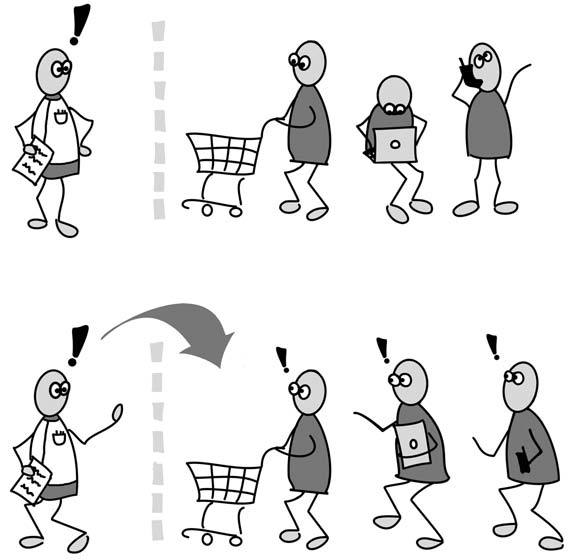
In Davies’ study, she also found discussions among some scientists who spoke positively of communicating science to the public. They described it as “highly context-dependent and perhaps most significantly saw it as a two-way (though somewhat limited) debate.” Those who had more contact with their lay audiences recognized the need for more nuanced versions of their messages. Rather than talking about a single public, they considered “publics.” Moreover, the public in this case is not a knowledge vacuum but an active and opinionated body.
“People generally make up their minds by studying more subtle, less ra-tional factors,” says author Chris Mooney. “So like it or not, those seeking a broader public acceptance of science must rethink their strategies for conveying knowledge. Especially on divisive issues, scientists should package their research to resonate with specific segments of the public” (Nisbet and Mooney 2007).
Overcoming the Fear Factor
At first, Pat Conrad, a professor at UC Davis’s School of Veterinary Medicine, was afraid to communicate her findings on what was causing California’s sea otters to disappear. She explains, “Our life’s work in research can be distorted by the media. . . . In regards to the public and policymakers, we aren’t really sure what is worse, to be ignored and have the significance of our research go unrecognized or to be acknowledged but misunderstood.”
To help overcome her misgivings, she did the Leopold Leadership training. There, she figured out how to communicate messages that she knew people would not want to hear: that sea otters were being killed by a parasite called Toxoplasma gondii, passed from cat feces to the oceans via runoff from land. The solutions include controlling feral cats, keeping cats indoors, cleaning up cat poop outside, and not flushing kitty litter down the toilet.
Conrad realized that making herself part of the story was important to win the minds and hearts of the public and policymakers. Empathy is critical to getting across her message that cats are the indirect cause of disease in sea otters and that cat-owners can do something about it. She had to make it clear that she was not a hard-hearted cat hater, she loves cats, and has three of her own. But because she knows that Toxo “eggs” are not killed by waste water treatment, she cleans up all the cat poop and seals it in trash bags for deposit in a sanitary landfill.
Conrad’s decision to go public led to awareness in coastal communities, as well as re-gional and state water quality boards. Ultimately, it resulted in legislation that mandated informative labeling on kitty litter, directed funds toward sea otter protection, and re-formed runoff regulations. The Sea Otter Bill became law January 1, 2007. For more details, see www.seaotterresearch.org
Reflecting on her experience, Conrad says, “Scientists have a responsibility to trans-late the results of their research for the public and policymakers, both directly and by telling their stories through the media. By understanding how their perspectives differ, we can become better storytellers and scientists.” But first, you have to get over the fear factor.
The reason to step up to the plate is that no one knows your research better than you, but you need a new way to think about transmitting your in- formation. The window of opportunity for engaging journalists, policymak- ers, and virtually everyone else is narrow. Speaking faster, louder, or covering more ideas in fewer words—hoping some portion will make it through the crack before the window slams shut—never really works. To be successful your message must be easily understood, memorable, and, most important, relevant to your audience.
The following guidelines will help you convince your audience to open the window a little wider—and to keep it open.
Step One: “So What?”
These two little words—“so what?”—are what your audience is asking. Why should I care about what you are saying? Or as Cory Dean of the New York Times often asks, “Why are you telling me this?” If you begin by thinking about their values, expectations, and interests, you can translate your informa-tion in a way that resonates instead of just dousing them with what’s on your mind.
When you talk to journalists, take it a step further and consider their au-dience. A journalist who works for the Wall Street Journal will have a different audience in mind than, say, one who works for National Geographic. Juliet Eilperin of the Washington Post explains, “I write about things that have na-tional and international policy implications. My immediate audience is everyone from the president on down: national policymakers in the United States all consume the Washington Post, so we are always thinking about them.”
Every audience is different, so you have to be ready to modify the way you express your main message. Think of it as passing your message through a prism—each audience has a different “so what?” What will be uppermost in the mind of a policymaker? What do resource managers care about? What is in it for a particular NGO? What might get a specific journalist interested?Why should the public care? It’s important to customize what you say and how you say it to your particular audience.
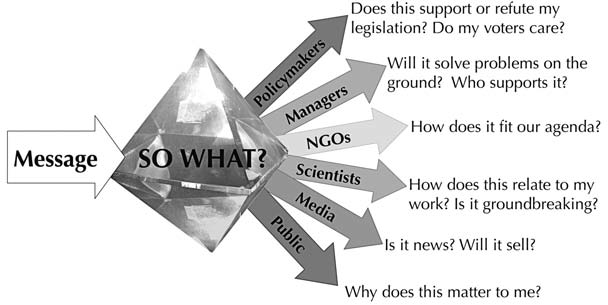
Step Two: The Message Box
If you want me to give you a two-hour presentation, I am ready today. If you want only a five-minute speech, it will take me two weeks to prepare. —Mark Twain
Scientists know too much and struggle to simplify it. “Once we know some-thing, we find it hard to imagine what it was like not to know it,” write Chip and Dan Heath in their useful book, Made to Stick (Heath and Heath 2007). “It becomes difficult for us to share our knowledge with others because we can’t readily re-create our listener’s state of mind.” Scientists are bedeviled by this “curse of too much knowledge.” It compels you to ignore the big picture, to delve too deeply into the topic, and to flood your audience with too much information.
The message box is a deceptively simple tool that helps you sift through the mountain of information in your mind and focus on the few key mes-sages that will be most salient for your audience. It helps take what you know, prioritize the most important information, and figure out how to frame and deliver it.

The message box can help you:
• Explain what you do to nonscientists
• Prepare for interviews
• Refine your thirty-second elevator speech for talking to policymakers
• Polish an abstract or cover letter for a publication
• Write an effective op-ed or press release
• Storyboard your website
The message box consists of four quadrants arrayed around a central issue. Here are the questions that should be answered in each of these sections:
Issue: In broad terms, what is the overarching issue or topic?
Problem: What is the specific problem or piece of the issue I am addressing?
So What?:Why does this matter to my audience?
Solutions:What are the potential solutions to the problem?
Benefits:What are the potential benefits of resolving this problem?
The message box is especially effective because it is nonlinear. There is no need to start with any particular component and work your way through step-by-step. If a conversation opens with a question about solutions, you can start there. The quadrant layout mentally prepares you to circle back to your main points no matter where you begin.
The message box works for any audience, but let’s focus on journalists for the moment. The message box keys into the questions that journalists need to know to turn your information into a story. Used effectively, it strips away all the details that matter to scientists but can distract others, and zeroes in on the core ideas that you want to convey. 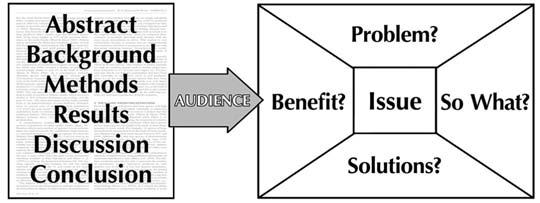
As you work through the message box, keep in mind that messages:
• are the core ideas you are trying to get across, not necessarily sound bites.
• must be simple, but not necessarily simplistic.They can be explained in a sentence.
• must be limited to three or four ideas—one if it’s for television.
• must be jargon-free.
• should be supported by sound bites, metaphors, statistics, and anecdotes (sparingly; see the next s ection).
More advice and examples are available on the website.
A designer knows he has achieved perfection not when there is nothing left to add, but when there is nothing left to take away.—Antoine de Saint-Exupery
Despite some initial skepticism, the scientists we train inevitably say that the message box is one of the most important things they have learned. They use it time and again to prepare for an interview, design a talk, and even to write papers and grant proposals.
Step Three: Support the Messages
Once you are satisfied that you’ve chiseled out the most important messages, you can add the bells and whistles. In order for your messages to hit home, you need to make them interesting and relevant by using specific examples, statistics, metaphors, and anecdotes. While your core messages shouldn’t change, how you express them and make them compelling depends on your target audience.
Following are some suggestions to help you refine your messages.
The Numbers Don’t Speak for Themselves,Actually
When you are immersed in your data it’s easy to forget how differently the rest of the world deals with numbers. Statistics can be powerful tools for mak- ing your message memorable. But, you must use them sparingly, with an un- derstanding of how they are likely to be received.When I tell scientists that the vast majority of journalists and policymakers can’t read graphs, or figures, they find it hard to imagine. But they just don’t speak that language, so when- ever you present data you have to say,”What this tells you is. . . .”
In covering a story, journalists will only use one or two key numbers and, even then, probably in conversational terms.You will have to sacrifice some degree of precision, but you can make sure that your number is usable, mem- orable, and still faithful to the data by following these suggestions:
- Sum it up and simplify: Never rely on your audience to do math in their heads. Instead of reporting multiple values for different years, give the total difference. Round off the numbers and translate them into con- versational terms.
- Use frequencies instead of probabilities: Even knowledgeable audiences struggle to understand probabilities. Studies show that values expressed as natural frequencies (for example, “only three in 10,000”) significantly improve the understanding of experts and nonexperts alike (Hoffrage et al. 2000).
- Compare and contrast:You may have worked for months to produce a single number, but it is useless unless you tell us what it means. Com- parisons are a natural way of putting a number into context. For exam- ple, on average, only one person dies from shark attacks in the United States each year. In comparison, lightening strikes kill almost fifty peo- ple (International Shark Attack File).
- Significance versus magnitude: Lay audiences do not understand the meaning of significance in a statistical sense. Small but significant dif- ferences can sound unimpressive and unimportant. If you can, present data so that the magnitude is striking. Instead of saying “we’ve seen a 4 percent annual decline since 1992,” say “we’ve lost more than 260,000 square miles in the past twenty years, which is an area the size of Texas.”
Instead of Saying This
A 90 percent increase in population. Annual coral cover loss was 1 percent over the last twenty years and 2 percent be-tween 1997 and 2003
The lifetime probability of developing liver cancer is 0.46 percent
Try This
- The population almost doubled. We are now losing coral reefs more than twice as fast as we are losing rainforest.
- Out of every 1,000 people, less than 5 will develop the liver cancer.
Think ahead: what misinterpretations are likely and how can you avoid them? How can you state your results in the most powerful terms? Sum it up, simplify, and tell us what it means . . . or someone else will do it for you and may get it wrong.
Jargon Watch
I don’t want you to pretend that you’re a beat poet. I want you to sound like a scientist, but be judicious about how you use technical terms. Sprinkle a few in, like bacon bits on my salad of information. —Douglas Fox
argon serves a useful purpose, but only with your peers. It enables insiders to communicate concisely and precisely—to use one word instead of many. However, it is exclusive. In order to communicate your ideas broadly, the so-lution is the same as with any other language barrier: you need to translate.
We often hear scientists lament, “I’m just not sure how far to dumb it down.” As a rule, journalists, policymakers, and the “science-interested” pub-lic do not lack the intellectual firepower to understand your work. What they lack is the highly specialized knowledge base—and the vocabulary that goes with it—that you have spent your entire professional career building. Use everyday words to get your meaning across.
Instead of Saying This Try This
“Microbiota” “Tiny living things”
“Hypoxic” “Low on oxygen”
“Trophic structure” “Food web”
“Piscivorous” “Eats fish”
“Pelagic” “Open water”
“Phototactic” “Moves in response to light”
When we talk about how most audiences lack the background to under-stand the language of their work, many scientists respond by asking, “But isn’t this an opportunity to educate?” This is a reasonable reaction. But by putting yourself in the role of educator, you run the risk of trying to impart, explain, and define so much new information that your core message can be lost in the process. When you speak to a room of college freshmen your goal is bring them, however incrementally, a bit closer to your level of understanding of a sprawling and complex body of knowledge. When you speak to a journalist, policymaker, or other educated nonscientist however, your goal is to make them understand a message in the context of why it matters.
Be strategic in deciding which concepts and terms to define or explain in greater detail. There may be one or two words or phrases that are so common and so important to your work that it will actually save you time to define them. But limit yourself. Definitions you want them to learn can compete with your take-home message.
Framing Your Argument
Framing is not about spin, or manipulation. As a conceptual term, “frames” are interpretative storylines that communicate what is at stake in a societal debate and why the issue matters (Gamson and Modigliani 1989).
Figuring out the most effective frame for your messages takes some thought.When Jonathan Patz of the University of Wisconsin published a re- view paper in Natur_e _titled “Impacts of regional climate change on human health” (Patz et al. 2005), he was determined to communicate it effectively. He used the message box to help him prepare. Below we show two versions of his message box: his initial attempt, and where he eventually ended up.
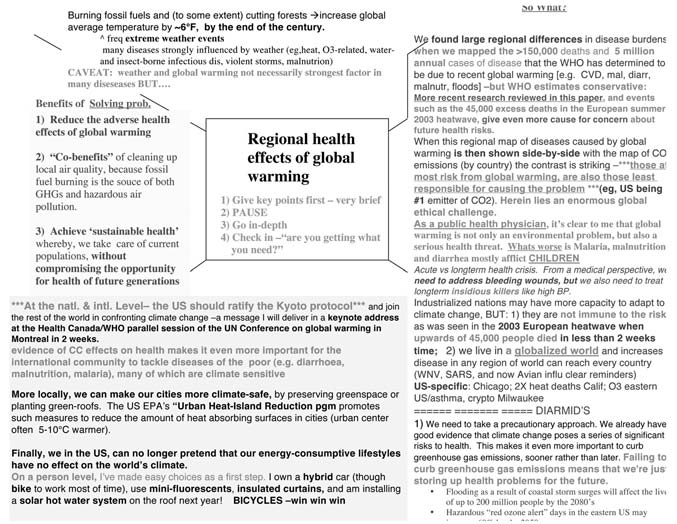
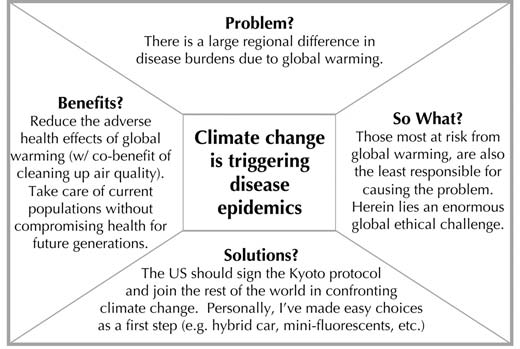
Like most scientists, Patz suffered the curse of too much information. When he first started talking about his paper, he sounded like the first mes-sage box appears—overwhelming. He struggled to find a clear message from the many things he wanted to say. Moreover, since it was a review paper, he had difficulty justifying the newsworthiness of his study to himself. But once he had it all listed into the message box format, he started whittling and grouping key messages. This clarified his thinking, and led him to a surprise: he and his coauthors had not clearly articulated the most powerful message of all: “Those most at risk from global warming are least responsible for causing the problem. This is a global ethical problem.” Framing his message this way expanded the relevance of their paper from an environmental health issue to a human rights issue, which he realized would have much greater salience internationally.
When he approached Juliet Eilperin at the Washington Post to tell her about his study, she found this message so compelling that she arranged for the Post‘s art department to produce a graphic that wasn’t included in the original paper. The Post‘s graphic juxtaposed a map of greenhouse gas emis-sions by country which underscored Patz’s main point. It was too late to add the second map to the Nature paper, but the Washington Post story effectively conveyed the message to the many decision-makers and others who read the Post (Eilperin 2005).
Media the world over reported Patz’s message almost exactly as he artic-ulated it. Soon after the news broke, he was invited to give the keynote ad-dress at the World Health Organization/Health Canada meeting at the IPCC Convention of Parties venue in Montreal and many other repercussions.
Patz says, “This experience with a simple—albeit well-placed—review paper, made me realize that from one small opportunity you can have a world-reaching impact.”
Making Your Messages Memorable
Try passing through a room of with a tray of items heaped in a pile. When you return, ask your colleagues (or your kids), what was on the tray? They will remember different things, and some will recall more than others. But if you leave the room and return with only four things on the tray, it is likely that everyone will remember the same four things. If you want your messages to be memorable, less is more.
When anyone starts working on a message box, it’s typical to pile many thoughts in each cell of the message box. That’s fine: it’s part of the brain-storming process. However, the next step is to sift through these ideas and de-cide which is most important. This process of ongoing refinement takes time.Once you have decided what your key messages are, the next step is to figure out how to convey them in a way that will “stick.”
Framing plays a role. Patz’s “global ethical issue” had traction because it evoked a moral and emotional response from people who might not care much about the environment. It’s not fair that our emissions are making peo-ple ill in parts of the world that produce few emissions. We are wired to feel things like injustice, so this point stuck with a broad audience much more powerfully than any abstraction about emissions could have.
To really make your messages stick, you need a catchy sound bite or metaphor that will convey your complex idea in a way that is easy to under-stand. You will know when it works because people will repeat it. For exam-ple, “rainforests are the lungs of the planet” has been used to the point of be-ing a cliché. It worked because it is a simple shortcut for a big idea that anyone could understand.
Steve Palumbi, director of Stanford University’s Hopkins Marine Lab, says, “I’ve realized that most people don’t live in logic-land all the time; they are feeling things. And scientists feel things too. We just tend to wrap it all up in logic and prove it.” When Palumbi was writing his first general science book, The Evolution Explosion: How Humans Cause Rapid Evolutionary Change, he tried to consider what people would feel about the information.To make the science relevant to readers, Palumbi worked at coming up with meta- phors to describe what was going on:

For example, you might know that taking antibiotics the wrong way creates an evolutionary arms race that leads to the drug failing to work. If you know that may be going on in your own body, if you know you could be damaging yourself by doing this, how does it make you feel?
Palumbi admits he doesn’t always get it right at first, so he tests his ideas:
Some of the metaphors I’ve tried are terrible. Some of them make no sense. Some of them make people laugh at you. Some of them make people look at you and say . . . what in the world are you talking about? But I keep at it until I find one that works.
Once you figure out a good way to get your core message across, there’s nothing wrong with using it over and over again. Politicians, advertisers, and kids prove the effectiveness of this tactic every day.
Finally, be careful to use examples that will resonate with specific audi-ences. For example, in the case of the paper by Ransom Myers and Boris Worm titled “Rapid Worldwide Depletion of Predatory Fish Communities” (Myers and Worm 2003), their overarching message was that 90 percent of the big fish are gone. But if they were talking to media in the Gulf of Maine After the Myer and Worm paper, there was a deluge of cartoons with the headline, “90 per-cent of big fish are gone.” Here is an example.
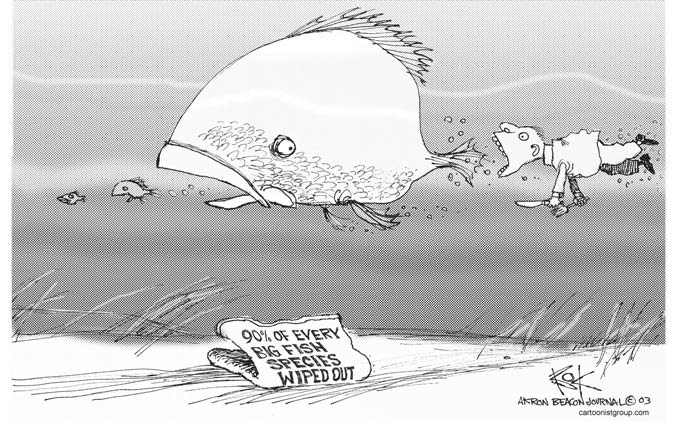
BOX 8.2
Master of Metaphor
Fisheries biologist Daniel Pauly is well known for his ability to come up with vivid metaphors that make his messages memorable. Here are a few examples:
- “We are fishing for bait and headed for jellyfish.”
- “Long-lining has expanded globally. It is like a hole burning through paper. As the hole expands, the edge is where the fisheries concentrate until there is nowhere left to go.”
- “The fishing industry has acted like a terrible tenant who trashes their rental.”
they talked about cod and swordfish, and if they were talking to a journalist in Florida, they pointed to their data on grouper. They were able to get people to care about their big-picture message by using local examples.
If your message has really penetrated society, you might even see cartoons riffing off it. That’s when you know you’ve truly made your point.
Know Your Headline
Once you have boiled all your ideas down into one message box, you are ready to distill it further until you find the one-phrase headline for your story.
I worked with Drew Harvell of Cornell University and Andrew Dobson of Princeton University and their coauthors to help them communicate a re-view that would be published in Nature, titled “Climate Warming and Disease Risks for Terrestrial and Marine Biota” (Harvell et al. 2002). While interview-ing Dobson for the press release, I kept pushing him for a headline. He couldn’t think of one. After we had talked for more than an hour I circled back and asked him again, “Okay, what’s the headline?”
BOX 8.3
Boris Worm Discusses the Message Box
Boris Worm, assistant professor of biology at Dalhousie University, studies marine bio-diversity at the global level. Quiet and reflective by nature, Worm had a series of papers that thrust him into the media limelight when still a postdoctoral fellow in 2003. Since then, several other papers have followed. These high-profile, high-stakes papers have at-tracted much positive and negative attention. Throughout, Worm has worked hard at becoming an effective communicator. Early on, he learned that the message box could help. I interviewed him in October 2009.
What have you learned about getting your message across?
It’s really about prioritization.You have a bunch of things you would like to talk about but really, at the core of it, if somebody has just one minute, what would you say?
What is your personal process to prepare for an interview?
I always try to be in a quiet room and to have a few minutes to concentrate to let all the clutter in my head fade away. A botched interview is often one that was given on the fly. So I look at the paper again, and the press release, and the message box, and highlight key points that I absolutely need to make. Then I think about the person who is calling—whether it’s someone with an interest in ecology or eco-nomics or whatever angle. Or maybe it’s a story that’s more personal; this person is likely to ask about my background, so I should think through a few points about that. Journalists really value and appreciate it when they feel you are orga-nized and on point—not fumbling around with lots of different ways of trying to explain one thing but you didn’t say clearly what the one thing is. It is so much less work to interpret what the heck you mean.
Tell me about what you are doing now with your grad students to help them be better communicators?
I force them to give one-minute statements about their thesis research because it helpsthem be clear about what they are actually trying to achieve. It comes up all the time. People ask, “What are you working on?” Sometimes a student might say, “I am working on lobster.” That doesn’t mean anything. Or they give a-ten minute detailed presentation of the method they are using, but never talk about the main question, or answer the question “so what?”
Everybody gets lost in detail so quickly and the world is so full of clutter and unnecessary information that doesn’t really mean much. So it’s refreshing when someone is able to give facts that matter in a way that everyone can understand. And it helps the listener or interviewer understand arguments that are very complex but are presented in a way that can be absorbed easily. That’s a learned skill that comes with practice and experience with things like the message box, or un-derstanding how journalists build a story.
I give my students the message box when they are going to be called up by media and that’s when they find it really helpful. But even just in lab meetings, or when we have a visitor and I am introducing them to my lab, I ask my students to tell the visitor what they are working on in one minute. It’s light, but I find it really helps.
He stammered a bit, but then spit it out: “A Warmer World Is a Sicker World!” Bingo—that was it. Sure, there were caveats and exceptions, but this headline crystallized the authors’ key message. It caught people’s attention. Journalists used it. The headline went a long way to helping them get their message across. And it stuck.
Prepare to Dance
The point of the message box is to help you prepare ahead of time. When used to its fullest extent, it helps you determine where you want to go, yet get there in a way that sounds natural and easy. If you do it right, no one listening to you would ever know that you were working from a blueprint.
Think of it like learning a basic dance step—say a meringue. On the first few attempts it may look and feel unnatural as you try to get the basic moves down. But with a little dedicated practice you can start adding the clever stuff—the twirls and flourishes. These are the sound bites, the statistics, the metaphors, and the little anecdotes that bring your message box to life.
Think of the journalist as your dance partner. A successful interaction de-pends on you both feeling like you are in rhythm. I have seen some disastrous interviews where scientists have clung too rigidly to their message. No mat-ter where the journalist tried to go, the scientist just mercilessly repeated the same message over and over again. They refused to “dance” with their partner.
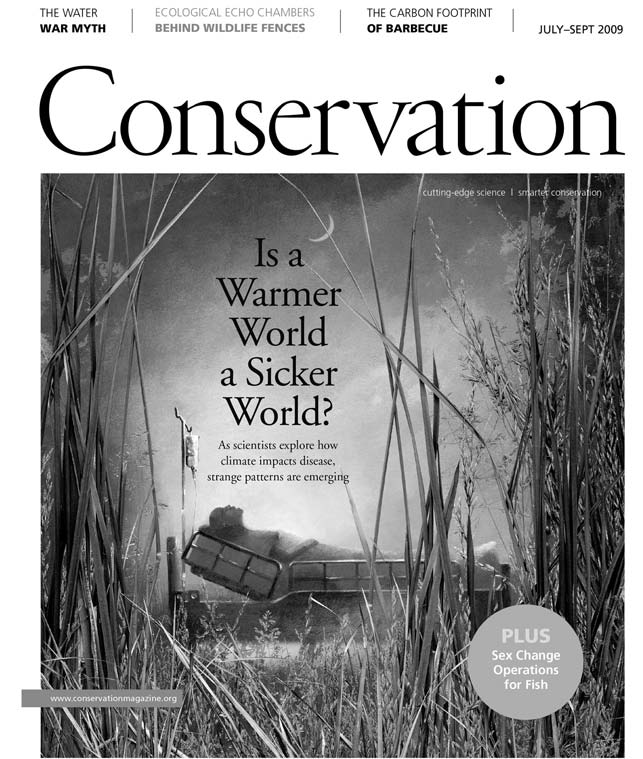
This headline has become a meme for the entire concept of climate change and disease dy-namics. Try Googling it—as of this writing, some 93,900 hits come up. Posed as a question, it was Conservation Magazine’s summer 2009 cover story.
In situations like these, the scientist comes off badly, and the journalist feels exasperated.
This serves nobody. You want to prepare yourself to engage in lively con-versation, or address challenges, while keeping the points you want to cover in mind. Use it, and you will feel satisfied instead of panicked when the jour-nalist says, “thank you very much—I’ve got a deadline, gotta run.”
The Bottom Line
Less is more. Cornelia Dean describes an interview where she asked a scien-tist if he could explain something more simply. He thought about it and replied, “No.” Not true! With a bit of effort, everything can be explained suc-cinctly in universal language. The purpose of the message box is to help you do this. Many of the best scientist communicators I know swear by it—so give it a try.

